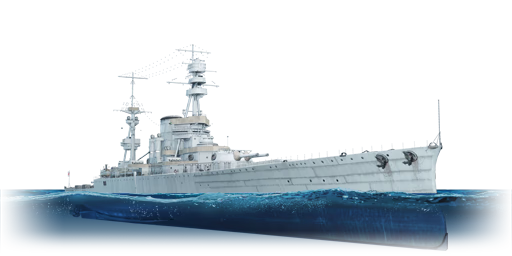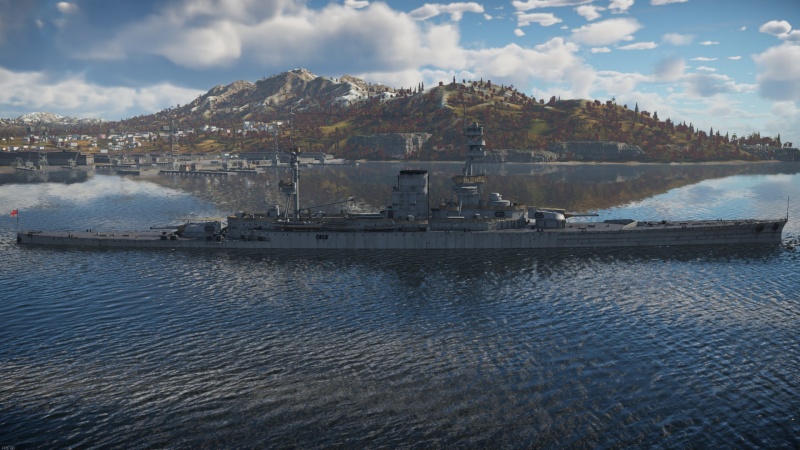Difference between revisions of "HMS Glorious"
m (→History: fixed wrong date of sinking of Glorious,1940, not 1943) |
(→Usage in battles: a starting primer for how to use it) (Tag: Visual edit) |
||
| Line 63: | Line 63: | ||
== Usage in battles == | == Usage in battles == | ||
| − | + | As a "glass cannon" the usual rule applies - try not to get hit!! | |
| − | + | ||
| + | At 5.7 BR in AB you should not bring the Glorious into matches where it will face "real" battleships and battlecruisers - against them it is simply a larger and hence easier target than normal cruisers. | ||
| + | |||
| + | However in a 6.0 or lower match you can use your unusual armament to advantage - the 15" guns can kill any cruiser with 3 or 4 good hits. If you have destroyers nearby consider swapping to control the 4" guns and engage them - you can get up to 12 x 4" guns on a broadside, which can rapidly wreck any small ship. The 4" SAP ammunition is significantly better for this than the stock HE. | ||
=== Pros and cons === | === Pros and cons === | ||
| Line 104: | Line 107: | ||
;Skins | ;Skins | ||
| + | |||
* [https://live.warthunder.com/feed/camouflages/?vehicle=uk_battlecruiser_glorious Skins and camouflages for the {{PAGENAME}} from live.warthunder.com.] | * [https://live.warthunder.com/feed/camouflages/?vehicle=uk_battlecruiser_glorious Skins and camouflages for the {{PAGENAME}} from live.warthunder.com.] | ||
Revision as of 04:38, 30 April 2023
Contents
Description
The Courageous-class, HMS Glorious (56), 1919 is a rank British battlecruiser with a battle rating of (AB), (RB), and (SB). It was introduced in Update "Fire and Ice".
One of the trio of the Courageous-class "large light cruiser", the HMS Glorious's design perfectly encapsulates Fleet Admiral Jackie Fisher's obsession with speed and firepower. Designed to get around the restriction to build new capital ship by the government, the Glorious' appearance is akin to that of a half-finished battleship with protection nowhere close to an actual battleship. Fortunately for the Glorious and her sister ship, the ship would later be converted into an aircraft carrier to put the better use for the wasted deck space after the Great War.
In War Thunder, the Glorious' unconventional design made her distinctive from the other "pocket battleship" at her BR, such as Graf Spee and the Ikoma. The ship is a true "glass cannon", featuring high offensive firepower in the form of four 381 mm cannons, numerous 102 mm guns, a truckload of torpedoes, along with good mobility to boot. But it still lacks an adequate armour to shield her off from enemy fire.
General info
Survivability and armour
Talk about the vehicle's armour. Note the most well-defended and most vulnerable zones, e.g. the ammo magazine. Evaluate the composition of components and assemblies responsible for movement and manoeuvrability. Evaluate the survivability of the primary and secondary armaments separately. Don't forget to mention the size of the crew, which plays an important role in fleet mechanics. Save tips on preserving survivability for the "Usage in battles" section. If necessary, use a graphical template to show the most well-protected or most vulnerable points in the armour.
Mobility
Write about the ship's mobility. Evaluate its power and manoeuvrability, rudder rerouting speed, stopping speed at full tilt, with its maximum forward and reverse speed.
| Mobility Characteristics | |||
|---|---|---|---|
| Game Mode | Upgrade Status | Maximum Speed (km/h) | |
| Forward | Reverse | ||
| AB | |||
| Upgraded | |||
| RB/SB | |||
| Upgraded | |||
Modifications and economy
Armament
Primary armament
Provide information about the characteristics of the primary armament. Evaluate their efficacy in battle based on their reload speed, ballistics and the capacity of their shells. Add a link to the main article about the weapon: {{main|Weapon name (calibre)}}. Broadly describe the ammunition available for the primary armament, and provide recommendations on how to use it and which ammunition to choose.
| Penetration statistics | |||||||
|---|---|---|---|---|---|---|---|
| Ammunition | Type of warhead |
Penetration @ 0° Angle of Attack (mm) | |||||
| 1,000 m | 2,500 m | 5,000 m | 7,500 m | 10,000 m | 15,000 m | ||
| 4crh CPC | SAPCBC | 487 | 462 | 427 | 399 | 377 | 345 |
| 4crh Mark XIIa APC | APCBC | 644 | 597 | 528 | 470 | 422 | 357 |
| Shell details | ||||||||||||
|---|---|---|---|---|---|---|---|---|---|---|---|---|
| Ammunition | Type of warhead |
Velocity (m/s) |
Projectile mass (kg) |
Fuse delay (s) |
Fuse sensitivity (mm) |
Explosive mass (TNT equivalent) (kg) |
Ricochet | |||||
| 0% | 50% | 100% | ||||||||||
| 4crh CPC | SAPCBC | 752 | 871 | 0.035 | 26 | 58.6 | 48° | 63° | 71° | |||
| 4crh Mark XIIa APC | APCBC | 752 | 871 | 0.025 | 26 | 20.68 | 48° | 63° | 71° | |||
Secondary armament
Some ships are fitted with weapons of various calibres. Secondary armaments are defined as weapons chosen with the control Select secondary weapon. Evaluate the secondary armaments and give advice on how to use them. Describe the ammunition available for the secondary armament. Provide recommendations on how to use them and which ammunition to choose. Remember that any anti-air armament, even heavy calibre weapons, belong in the next section. If there is no secondary armament, remove this section.
| Penetration statistics | |||||||
|---|---|---|---|---|---|---|---|
| Ammunition | Type of warhead |
Penetration @ 0° Angle of Attack (mm) | |||||
| 1,000 m | 2,500 m | 5,000 m | 7,500 m | 10,000 m | 15,000 m | ||
| 4 inch HE | HE | 11 | 11 | 11 | 11 | 11 | 11 |
| 4 inch SAP | SAP | 90 | 72 | 51 | 37 | 28 | 24 |
| Shell details | ||||||||||||
|---|---|---|---|---|---|---|---|---|---|---|---|---|
| Ammunition | Type of warhead |
Velocity (m/s) |
Projectile mass (kg) |
Fuse delay (s) |
Fuse sensitivity (mm) |
Explosive mass (TNT equivalent) (g) |
Ricochet | |||||
| 0% | 50% | 100% | ||||||||||
| 4 inch HE | HE | 805 | 14.06 | 0 | 0.1 | 721 | 79° | 80° | 81° | |||
| 4 inch SAP | SAP | 805 | 15.2 | 0.015 | 5 | 520 | 47° | 60° | 65° | |||
Anti-aircraft armament
An important part of the ship's armament responsible for air defence. Anti-aircraft armament is defined by the weapon chosen with the control Select anti-aircraft weapons. Talk about the ship's anti-air cannons and machine guns, the number of guns and their positions, their effective range, and about their overall effectiveness – including against surface targets. If there are no anti-aircraft armaments, remove this section.
Additional armament
Describe the available additional armaments of the ship: depth charges, mines, torpedoes. Talk about their positions, available ammunition and launch features such as dead zones of torpedoes. If there is no additional armament, remove this section.
Usage in battles
As a "glass cannon" the usual rule applies - try not to get hit!!
At 5.7 BR in AB you should not bring the Glorious into matches where it will face "real" battleships and battlecruisers - against them it is simply a larger and hence easier target than normal cruisers.
However in a 6.0 or lower match you can use your unusual armament to advantage - the 15" guns can kill any cruiser with 3 or 4 good hits. If you have destroyers nearby consider swapping to control the 4" guns and engage them - you can get up to 12 x 4" guns on a broadside, which can rapidly wreck any small ship. The 4" SAP ammunition is significantly better for this than the stock HE.
Pros and cons
Pros:
- Four 381 mm guns, enough to cripple any enemy it might have to face
- Numerous fast-firing 102 mm provides steady damage output at mid-to-close range
- Huge empty space at the bow and stern can absorb several hits from shells and torpedoes
- Quite fast and manoeuvrable, despite the size
- Equipped with 40 torpedoes with decent performance
Cons:
- Very large and distinctive hull shape, easily identified and hit by any enemies
- Poor armour protection, relies heavily on fuel tanks to absorb damage
- Terrible main turret traverse speed, inability to fire reactively
- Poor anti-air defence
- Fixed torpedo tubes restrict its usage to saturational barrages
History
The Courageous-class battlecruisers were formulated during WW1 by the ever-eccentric First Sea Lord, Jacky Fisher, as part of his 'Baltic Project', a planned attack on the German Baltic coastline. In 1915, the Chancellor of the Exchequer had forbidden new construction of any warships larger than light cruisers, yet Lord Fisher wanted new fast capital ships for the Baltic Project in order to support his proposed landings of troops on the beaches of Pomerania.
In order to get around the rule against new capital ships and also because of Lord Fisher's obsession with speed at the expense of all else, the Courageous class were presented as 'large light cruisers', with extremely light armour, extremely high speed and half the main armament of the new Queen Elizabeth-class battleships. Fortunately for Fisher, many of the politicians up top had little knowledge in naval matters and so they saw the high speed, low armour and just approved the design for construction.
Unfortunately, however, the ships proved to be a little too lightly built and had a tendency to take structural damage in rough seas or at high speed or even when firing the main guns until they were structurally stiffened in response.
As Fisher's Baltic Project never took place, the ships spent the war patrolling the North Sea. HMS Glorious saw little action, other than the Second Battle of Heligoland Bight, during which she only suffered damage from a premature shell detonation and her own muzzle blasts. She was also present for the surrender of the German High Seas Fleet in 1918.
The Courageous-class battlecruisers were converted into aircraft carriers in the 1920s.
On the return journey of an evacuation of British aircraft from Norway in June 1940, HMS Glorious was attacked by the German battleships Scharnhorst and Gneisenau, losing over 1,200 lives in the battle. HMS Glorious remains on the floor of the Fjord today.
Media
- Skins
See also
Links to articles on the War Thunder Wiki that you think will be useful for the reader, for example:
- reference to the series of the ship;
- links to approximate analogues of other nations and research trees.
External links
| Britain battlecruisers | |
|---|---|
| Invincible-class | HMS Invincible |
| HMS Queen Mary* | |
| Renown-class | HMS Renown · HMS Repulse |
| Courageous-class | HMS Glorious |
| Admiral-class | HMS Hood |
| * Unique ship | |





